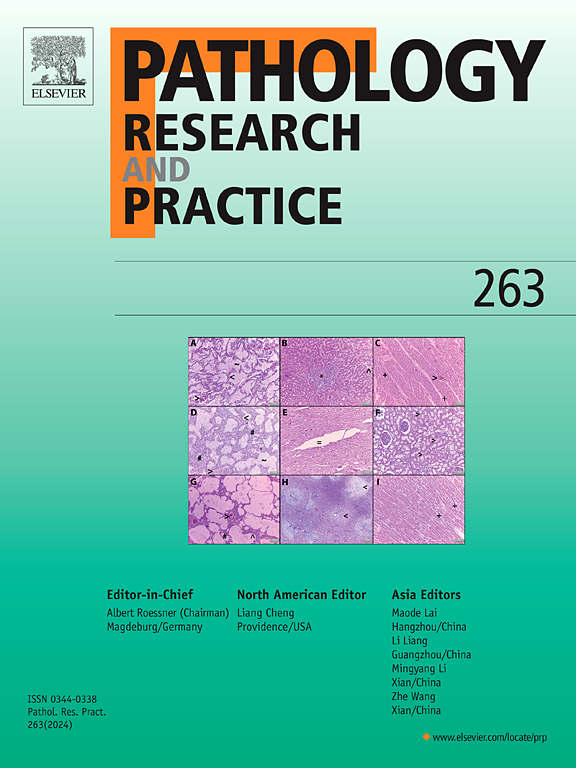Intracytoplasmic accumulation of keratan sulfate is a hallmark of granular cell tumor
IF 2.9
4区 医学
Q2 PATHOLOGY
引用次数: 0
Abstract
Granular cell tumor (GCT) is a relatively rare neoplasm characterized by abundant eosinophilic intracytoplasmic granules. More than three decades ago, Ehara and Katsuyama reported that GCT granules are recognized by the anti-keratan sulfate (KS) monoclonal antibody 5D4 and suggested that 5D4 could serve as a diagnostic marker for GCT. However, due to the small number of samples analyzed and incomplete structural analysis of KS, use of 5D4 as a GCT marker has not yet been widely accepted. To confirm its use as a GCT marker, we performed quantitative immunohistochemical analysis of GCT (n = 27) and other GCT-mimicking tumors/lesions (n = 82) including schwannoma (n = 10), neurofibroma (n = 10), melanocytic nevus (n = 10), leiomyoma (n = 10), gastrointestinal stromal tumor (GIST) (n = 10), malignant melanoma (n = 10), dermatofibroma (n = 10), angiosarcoma (n = 10) and malakoplakia (n = 2) using 5D4 and two other anti-KS monoclonal antibodies, R-10G and 297–11A, in combination with two endoglycosidases, keratanase II and endo-β-galactosidase. We found that most GCT tissues were immunostained with 5D4 and 297–11A, although tumors/lesions mimicking GCT showed minimal staining. Moreover, structural analysis revealed that KS accumulated in GCT consisted of both highly sulfated and low-sulfated KS located at non-reducing and reducing termini, respectively. Here we propose that intracytoplasmic KS accumulation is a hallmark of GCT, and that 5D4 and 297–11A could serve as diagnostic markers of GCT.
求助全文
约1分钟内获得全文
求助全文
来源期刊
CiteScore
5.00
自引率
3.60%
发文量
405
审稿时长
24 days
期刊介绍:
Pathology, Research and Practice provides accessible coverage of the most recent developments across the entire field of pathology: Reviews focus on recent progress in pathology, while Comments look at interesting current problems and at hypotheses for future developments in pathology. Original Papers present novel findings on all aspects of general, anatomic and molecular pathology. Rapid Communications inform readers on preliminary findings that may be relevant for further studies and need to be communicated quickly. Teaching Cases look at new aspects or special diagnostic problems of diseases and at case reports relevant for the pathologist''s practice.

 求助内容:
求助内容: 应助结果提醒方式:
应助结果提醒方式:


